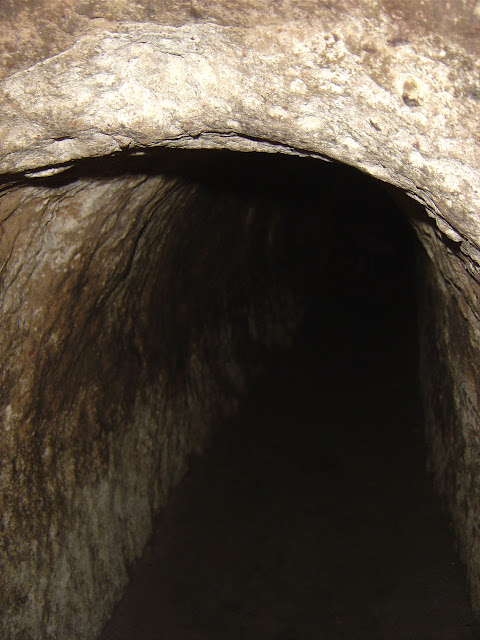 |
| The dark, forboding war tunnels of Cu Chi |
This time there’s no tile floors, or concrete walls. I’m surrounded by clayish-dirt. I’m in a very tight earthen cave, and there’s very little space around me. It is so cramped down here, that I’m forced to crawl on my hands and knees. With my vision useless, I can rely only on my sense of touch. As I crawl ahead slowly, each of my hands reaches forward in the blackness, feeling only damp dirt beneath. The walls and ceiling are so tight, it’s impossible for me to turn around. So this is what claustrophobia feels like.
I’m in the Cu Chi war tunnels, just north of the former city of Saigon. This was an enormous tunnel network built by Vietnamese rebels for use first against the French, and later used against the Americans. It is enormous in length only. The height and width of most of the tunnels were kept to a minimum. This meant that a short Viet Cong soldier could crawl through without much difficulty, while the taller, bulkier American soldiers couldn’t get through at all. That was the idea behind their narrow construction. American soldiers weren’t likely to follow the Viet Cong into small spaces where they couldn’t fit.
“It’s going down,” I hear from a nervous voice up ahead, another visitor in this world of darkness. I’m aware that this section of the tunnel has been widened, so someone as tall as I can still crawl through. But as if the dark and tight conditions weren’t enough already, now the tunnel is starting to slope downward. I’m going deeper underground. Crawling forward on a downward angle in the darkness is even more nerve wracking.
I’m inching through the tunnels with a group of visiting tourists, but most of the tour group hasn’t made it this far. Our larger group first entered the tunnels about 200 meters behind us. Back there, closer to the entrance, there was some lighting. But as we crawled ahead in the cramped conditions, the lights eventually ran out. Rounding a turn, the blackness surrounded us. Most of the other tourists couldn’t handle either the darkness, or the claustrophobic conditions. Since the war’s end, the only residents of these tunnels have been snakes, spiders and scorpions. The others escaped their fears by climbing out through side exits.
Now, there are only a few us left, feeling our way forward across the clayish soil of the tunnel floor, in total darkness. I’ve never even imagined conditions like this before. Try crawling for 400 meters sometime. Then try it totally blind. Next, try it in a tunnel so tight, that your shoulders bump the walls on both sides, and your head scrapes along the dirt ceiling. During the war the Viet Cong crawled around down here every day, and they crawled for far longer distances.
This vast tunnel network was more than 200 km long! The clayish soil of Cu Chi made for perfect tunneling conditions. The network stretched from the outskirts of Saigon, all the way to the Cambodian border. Some tunnels even reached under the American military bases. This underground network had just about everything the Viet Cong needed. These narrow tunnels widened out to become rooms for various uses. There were bunkers for fighting, and bunk rooms for sleeping. There were kitchens, storage rooms, meeting rooms, and even underground hospitals. In some places there were as many as three levels, descending deep beneath the earth.
The Americans eventually put together a unit of soldiers to pursue and fight the VC down in the tunnels. Shorter and smaller in stature than average American men, they became known as the Tunnel Rats. It’s hard to imagine how difficult it was down here then, crawling and fighting for their lives, armed with only a pistol and a flashlight. It's spooky enough down here as it is now. I can't imagine how terrifying it must have been down here then, when the Tunnel Rats and Viet Cong guerrillas fought to the death in the darkness.
While the tunnel rats fought undergound, American military might tried to destroy the tunnels any way they could. Aerial attacks, artillery, bulldozers, explosives, gas, and defoliants, none were enough drive the Viet Cong out of Cu Chi’s underground world. By the end of the war, Cu Chi became one of the most bombed out places in Vietnam. Between the craters and lack of vegetation from Agent Orange, the place resembled a moonscape, and the environment was destroyed.
 |
| Unexploded US bombs found in Cu Chi. They are still being found today. |
Despite their vast firepower and technology, the American military never managed to destroy the tunnel network. The network was just too long, and the VC kept right on digging more tunnels.
On the opposite end, despite many attacks, the Viet Cong never managed to capture any of the vast US bases around Cu Chi while the Americans were still here. The conflict here was more or less a stalemate. But the VC did manage to maintain a presence, and continued to harass the American bases. In that sense, the Cu Chi war tunnels aren’t really a monument to victory. They’re more of a monument to Vietnamese tenacity.
What an incredible adventure! you portray the experience very vividly... although it sounds a bit scary, it also sounds a bit out-of-this-world. I think I would love to take this adventure if I get the chance. Thanks for the share!
ReplyDeleteYou're welcome Lillian. It was certainly a weird feeling going down into those tunnels, if you ever go to Vietnam I would recommend it. It has to have been one of my most unusual travel experiences.
ReplyDelete